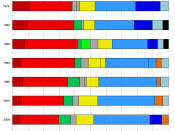Europe, one of the seven traditional continents of the Earth, consists of 55 countries. In terms of population, it is the third-largest continent with over 710,000,000 inhabitants or about 11 percent of the world's population. No wonder that during history the so-called Old Continent developed many socio-political, economical and cultural differences that last until today. But there was one thing the majority of Europe could agree on - the TV. Since the first broadcasting, short before the Second World War, the colorful and moving pictures conquered almost every European household. Year by year the audiovisual industry's economical, sociological and cultural importance grew. It became so big that by today we can say that television is the main hobby for Europeans. It plays a large cultural and social role and is the largest source of information and entertainment in Europe with 98 percent of homes owning at least one (Europa). Looking at this surprising dominance, it is less astonishing that the European Union decided that such a powerful medium has to be controlled and therefore introduced the Audiovisual Policy.
This essay will analyze the policy's two main pillars, the 'Television Without Frontiers' Directive and the MEDIA Pogrammes and their benefit to the member states (if there are any). It will further look at the question, if unified international guidelines are a purposeful regulatory body in a business that is based mainly on national needs.
In the end of the 1950s television became common in Europe's households and even gained popularity with the broadcasting switching from black and white to color. But it took another almost twenty years for European authorities to realize its true potential. It was probably the former President of the European Commission Jacques Delors, who opened the eyes of his colleagues and turned their eyesight towards the medium...


